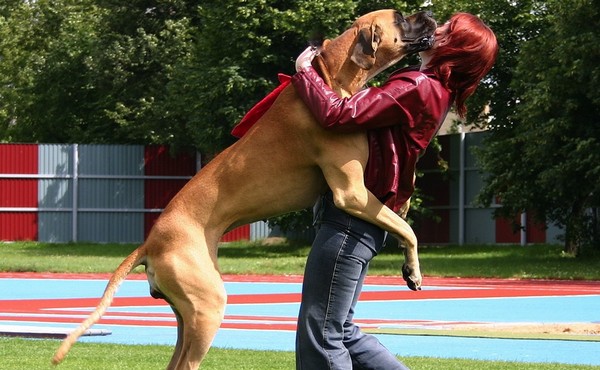What are some most common bad habits of dogs? How to overcome the bad dog behaviors? Have you ever been dealing with some kind of bad dog behavior? Here are top 10 bad dog behaviors, and tips to transform him into a wonderful companion. Remember, dogs are not born bad. They are influenced by their surroundings. Their bad behaviors are mostly because of their interactions with others, they may be uncomfortable in certain situations, Or it could be due to inconsistent or bad dog training.
Here are top 10 bad dog behaviors, and tips to overcome…
10. Chewing

Chewing is a very common bad behavior for dogs. Chewing is a dog’s natural way to relieve stress or stop from being bored. Chewing can also ease pain in puppies with new teeth, or in older dogs that have weakening jaws. Chewing is an acceptable behavior when a dog chews an appropriate item, such as a rawhide or dog toy. Most owners become frustrated when their dog chews furniture, shoes, electronics, etc. This type of behavior can be corrected through proper training, especially at a young age.
9. Jumping

Many dogs tend to jump on humans or other dogs when excited during a greeting. By nature, puppies jump on older dogs to smell their face, and therefore dogs do the same with humans. Jumping behavior can be a problem because injuries often occur. Untrimmed nails can scratch a person and a jumping dog can easily knock down someone, especially a child. It is important to teach dogs not to jump at an early age.
8. Leash pulling

Many dogs pull on the leash because they are over excited or over stimulated when on walks. Over stimulation can from the smells human don’t notice or the sounds humans can’t hear. Fast moving objects such as bikes, skateboards, or small animals can also cause excitement for a dog, which leads to them pulling when on walks. This type of behavior can be easily corrected through behavioral training.
7. Leash Aggressiveness

Some dogs feel stressed when being walked on a leash, as they feel they are confined or being controlled. When dogs feel this way, they can become over aggressive towards other dogs, people, or objects. Signs of leash aggressiveness include lunging, growling, or aggressive barking. Leash aggressiveness is common and can be treated with behavioral training.
6. Anxiety

Most dogs become anxious during the early stages of their life when they may not have been properly socialized with other animals or exposed to different environments. They may also have suffered some sort of trauma in their life, such as being hit by a car, abused, or neglected. Dogs that suffer from anxiety will often be fearful, aggressive, cower to other dogs or people, or attempt to run/dart from ‘scary’ situations. Behavior training can help stop anxiety in dogs. If the anxious behavior is severe, medication can be prescribed to help ease a dog’s anxiety.
5. Slobbering/Hypersalivation

Many pet owners have to deal with their dogs slobbering. Slobbering can be a result of dental issue, such as too much tartar, rotten teeth, or inflammation and irritation around a dog’s mouth. Excessive salivation can also be attributed to a dog’s breed. Mastiffs, Bloodhounds, and Bulldogs are common breeds that excessively drool. These types of breeds often have trouble holding in liquids because they have floppy mouth skin, short/narrow snouts, and large jowls. Dogs with long hair on their face, such as Schnauzers or Westies, tend to drip water after drinking. This is sometimes mistaken for drooling. Unless there is medical condition that can be treated, slobbering and excessive salivation is not a behavior that can be corrected.
4. Dog Aggressiveness

Many dogs become aggressive towards other dogs. Dogs that are aggressive often growl, bark, lunge, snap, and attack other dogs. They could become aggressive from fear or it could be a learnt behavior. Some dogs can become aggressive when they are forced into a situation they do not want to be in, such as meeting other dogs at the dog park or during walks. This type of behavior can be corrected through behavioral training. Some dog breeds have predisposed disposition to be more aggressive than others, and in some cases, a dog’s aggressive behavior can be a result of a medical problem.
3. Territorial Behavior

Dogs often defend the area they deem as their territory, or the area they think belongs to them. Common territories that dogs defend are their crate or sleeping area, the yards around their house, or the area around their food. Dogs can also be territorial of their dog toys. Typical signs of territorial behavior include growling, aggressive barking, biting, or frenzied behaviors. Territoriality in dogs is treatable and can be corrected through behavioral training.
2. Excessive Barking

Barking is a natural way of communicating in dogs, but many dogs bark when it is inappropriate or unnecessary. Common reasons a dog barks is to alert or sending a warning, when they are excited or greeting someone new, when thy feel threatened or afraid, or simply because they are being playful. Barking becomes excessive when the dog continues to bark even after the situation that initially caused the barking to start, has stopped. This type of behavior can be corrected through proper behavioral training.
1. House Soiling

Some dogs go to the bathroom in a house as a result of a behavioral problem. Dogs urinate or defecate when they are afraid or anxious, to show submission, or mark their territory. It I important to determine the exact reason your dog is spoiling in the house. By understanding the reason for this unwanted behavior, a proper treatment program can be created to stop this it from continuing to occur. Sometimes a dog will soil in the house as a result of an underlying medical problem and it is important to discuss this issue with a Veterinarian. The sooner this behavior is addressed, the more likely it is to stop.
Top 10 Bad Dog Behaviors
- House Soiling
- Excessive Barking
- Territorial Behavior
- Dog Aggressiveness
- Slobbering/Hypersalivation
- Anxiety
- Leash Aggressiveness
- Leash Pulling
- Jumping on People
- Chewing Inappropriate Objects
Author – B. Goss






